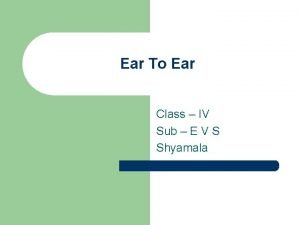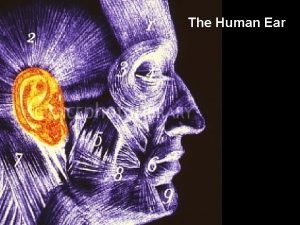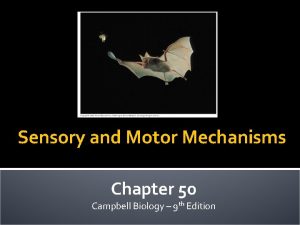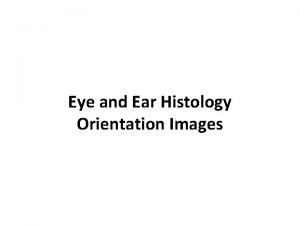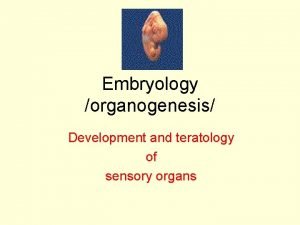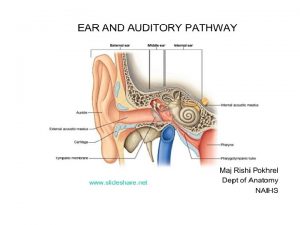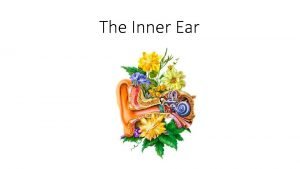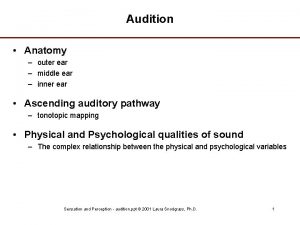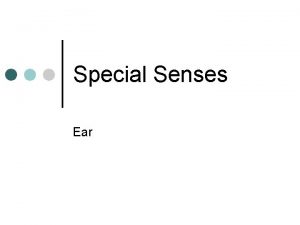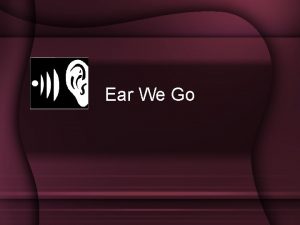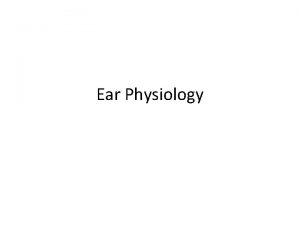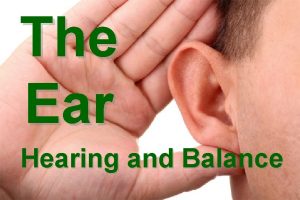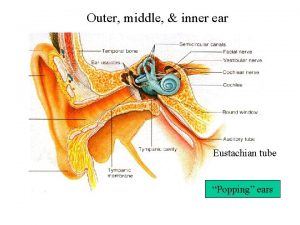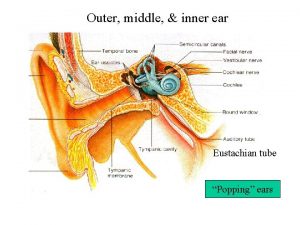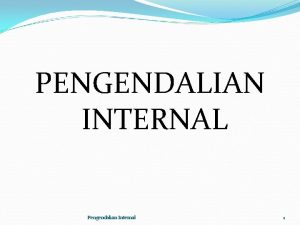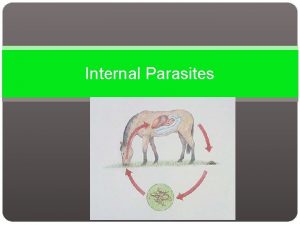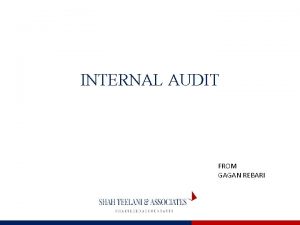The Inner Ear The internal ear inner ear






















- Slides: 22

• The Inner Ear The internal ear (inner ear) is also called the labyrinth because of its complicated series of canals – Structurally, it consists of two main divisions: an outer bony labyrinth that encloses an inner membranous labyrinth • the bony labyrinth is sculpted out of the petrous part of the temporal bone, and divided into three areas: (1) the semicircular canals, (2) the vestibule, and (3) the cochlea

• The Inner Ear The vestibule is the middle part of the bony labyrinth – The membranous labyrinth in the vestibule consists of two sacs called the utricle and the saccule (both contain rc for static equilibrium) • The cochlea , located anterior to the vestibule, contains rc for hearing • The three semicircular canals are above the vestibule, each ending in a swollen enlargement called the ampulla (for dynamic equilibrium)

The Inner Ear • The snail shaped cochlea contains the hearing apparatus – Two types of fluid (perilymph and endolymph) fill its 3 different internal channels: The scala vestibuli, scala tympani, and cochlear duct – A section through one turn of the cochlea is shown

• The Inner Ear Perilymph transmits the vibrations coming from the stapes in the oval window up and around the scala vestibuli, and then back down and around the scala tympani – causing the endolymph in the cochlear duct to vibrate – Pressure waves in the endolymph cause the basilar membrane of the cochlear duct to vibrate, moving the hair cells of the spiral organ of Corti against an overhanging flexible gelatinous membrane called the tectorial membrane

• The Inner Ear Note how the sound waves between the number 1 and number 2 in this diagram are shown impacting different parts of membranous labyrinth. This is a representation of sounds waves of different frequencies being transduced at the segment of the basilar membrane that is “tuned” for a particular pitch

The Inner Ear • Movements of the hair cells in contact with the tectorial membrane transduce mechanical vibrations into electrical signals which generate nerve impulses along the cochlear branch of CN VIII

The Auditory Pathway • This graphic depicts the events in the stimulation of auditory receptors, from channeling sound waves into the external ear and onto the TM, to the transduction of those vibrations into local receptor potentials

Malleus Incus Stapes vibrating Helicotrema in oval window Cochlea Sound waves Perilymph 3 7 4 5 1 2 6 9 External auditory canal 8 8 Scala tympani Scala vestibuli Basilar membrane Spiral organ (organ of Corti) Tectorial membrane Vestibular membrane Cochlear duct (contains endolymph) Tympanic membrane Secondary tympanic membrane vibrating in round window Middle ear Auditory tube

The Auditory Pathway • The cell bodies of the sensory neurons are located in the spiral ganglia. Nerve impulses pass along the axons of these neurons, which form the cochlear branch of the vestibulocochlear (VIII) nerve

The Auditory Pathway • The nerve impulses follow CN VIII en route to the medulla, pons, midbrain, and thalamus, and finally to the primary auditory cortex in the temporal lobe. Slight differences in the timing of nerve impulses arriving from the two ears at the superior olivary nuclei in the pons allow us to locate the source of a sound

Equilibrium • Equilibrium is another function of the inner ear controlled by the vestibular apparatus (the saccule and utricle of the vestibule, and the 3 semicircular canals) – Static equilibrium refers to a state of balance relative to the force of gravity – Dynamic equilibrium involves the maintenance of balance during sudden movements

Static Equilibrium • Static equilibrium is controlled by the sensory hairs within the macula of the utricle and saccule

Static Equilibrium • An otolithic membrane, studded with dense calcium carbonate crystals (otoliths), responds to gravity when head position is changed – This movement opens transduction channels in the hair cells, producing local potentials which summate to form nerve AP

Dynamic Equilibrium • Dynamic equilibrium is controlled by the sensory hairs within the ampulla of the semicircular canals –Within each ampulla is a small elevation called the crista

Dynamic Equilibrium • Each crista contains hair cells and supporting cells covered by gelatinous material called the cupula – With movement, the endolymph within the ampulla lags behind the moving cupola, causing a difference in the inertial forces – the hair bundle of the cupola bends and nerve impulses are generated

Equilibrium Pathway • Once generated, nerve impulse travel up the vestibular branch of CN VIII. Most of these axons synapse in the major integrating centers for equilibrium, in the medulla and pons, which also receive input from the eyes and proprioceptors – Ascending neurons continue primary auditory area in the parietal lobe to provide us with conscious awareness of the position and movements of the head and limbs

Homeostatic Imbalances • A cataract is an opaque defect in the cornea or lens of the eye – most cataracts are in the lens – Cataracts are causes by injury, medications, and diseases like diabetes. They are common in old age • Conjunctivitis is an inflammation of the conjunctival membrane which covers part of the front of the eye – Conjunctivitis is caused most frequently by viral infections (pink eye) and allergy. It can also result from bacterial infections and many other irritants

• Homeostatic Imbalances Age Related Macular Degeneration results in a loss of vision in the center of the visual field (the macula) because of damage to the retina. It is a major cause of visual impairment in older adults (>50 years) – It can become impossible to recognize faces, yet enough peripheral vision remains to allow other activities of daily life

Homeostatic Imbalances • Myringitis is an inflammation of the ear drum – Infections of the middle ear cavity (otitis media) are common in children between 6 mo. – 5 yrs. old, and usually presents with a crying child and a TM (viewed through an otoscope), that looks angry, red, and bulging • Otitis externa (commonly called “swimmer’s ear”) is a dermatitis of the epithelium of the outer ear (infectious and noninfectious). The chlorine, water, and ear plugs associated with swimming can result in irritated, inflamed tissues of the outer ear and ear canal

Distended Eardrum Caused by Otitis Media Dr. P. Marazzi/Photo Researchers, Inc.

Homeostatic Imbalances • Meniere’s disease is a disorder of the inner ear that can affect hearing and balance, and is thought to be due to increased pressure in the cochlea and semicircular canals (extra endolymph) – Episodes of vertigo (the room spinning) and ringing in the ears (tinnitus) can be a mild annoyance, or a chronic, disabling disability

End of Chapter 17 Copyright 2012 John Wiley & Sons, Inc. All rights reserved. Reproduction or translation of this work beyond that permitted in section 117 of the 1976 United States Copyright Act without express permission of the copyright owner is unlawful. Request for further information should be addressed to the Permission Department, John Wiley & Sons, Inc. The purchaser may make back-up copies for his/her own use only and not for distribution or resale. The Publisher assumes no responsibility for errors, omissions, or damages caused by the use of these programs or from the use of the information herein.
 Inner defender and inner guide examples
Inner defender and inner guide examples Slidetodoc
Slidetodoc Animals whose ears can not be seen
Animals whose ears can not be seen U
U Ear inner structure
Ear inner structure Retina layers
Retina layers Recessus tubotympanicus
Recessus tubotympanicus Helix crus
Helix crus Inner defender examples
Inner defender examples Elements of internal control system
Elements of internal control system Importance of vouching
Importance of vouching Gấu đi như thế nào
Gấu đi như thế nào Thiếu nhi thế giới liên hoan
Thiếu nhi thế giới liên hoan Số nguyên tố là
Số nguyên tố là Tỉ lệ cơ thể trẻ em
Tỉ lệ cơ thể trẻ em Vẽ hình chiếu vuông góc của vật thể sau
Vẽ hình chiếu vuông góc của vật thể sau Các châu lục và đại dương trên thế giới
Các châu lục và đại dương trên thế giới Thế nào là hệ số cao nhất
Thế nào là hệ số cao nhất Sơ đồ cơ thể người
Sơ đồ cơ thể người Tư thế ngồi viết
Tư thế ngồi viết Hình ảnh bộ gõ cơ thể búng tay
Hình ảnh bộ gõ cơ thể búng tay đặc điểm cơ thể của người tối cổ
đặc điểm cơ thể của người tối cổ Cách giải mật thư tọa độ
Cách giải mật thư tọa độ


